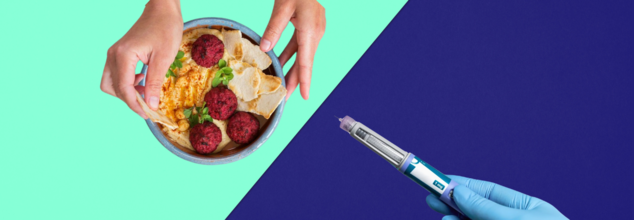- Health Conditions A-Z
- Health & Wellness
- Nutrition
- Fitness
- Health News
- Ayurveda
- Videos
- Medicine A-Z
- Parenting
- Web Stories

Credits: Canva
Why Every Indian Must Include Moringa Soup In Their Diets?
Even our PM does it, so should you!
In one of the recent episodes of the Figuring Out With Raj Shamani podcast, Mihir Gadani, co-founder of Ozivia Nutrition, called moringa one of the top three superfoods Indian should consume, daily.
As he shared his insights on its benefits, he also said, "Moringa is packed with antioxidants which contribute to the protective mechanisms in your body. Even PM Modi drinks moringa soup. But the problem is that it is slightly bitter in taste, so extracts of moringa can be used."
Why Should You Include Moringa Soup In Your Daily Diet?
Moringa or drumstick is loaded with vitamin C, A, E, calcium, iron, potassium, magnesium, and fiber. These nutrients make it superfood for your immunity, bones, liver, and digestion. What is even more beneficial is that it is rich in antioxidants that fight off free radicals. The fiber in it also helps with healthy gut.
Other benefits that make it a 'must-have' in your daily diet:
Iron
It is high in calcium and daily drumstick soup also helps boost bone density. It can also prevent osteoporosis.
Immunity Booster
The high vitamin C and antioxidants in the soup also enhances body's defense system. It helps you stay safe from infections.
Good For Liver
Moringa is known for its liver cleansing properties, it can protect from toxins. It helps in flushing toxins out of the liver. It is a great drink for detoxing your body.
Helpful With Diabetes
The fiber and antioxidant content in it also helps stabilize the blood sugar levels. It also helps in insulin sensitivity, and prevents sugar spikes. That is why it is the best suitable drink for diabetic patients.
Good For Skin
There have been studies too that suggested that the compounds in moringa also helps wounds heal faster. They also reduce oxidative stress on the skin and the moringa seed oil also helps in healthier hair.
Gut-Friendly
Moringa is also gut-friendly and it can reduce stomach acid secretion, and relieve inflammation.
Fights Bacterial Infections
There are lab tests that prove that moringa can also be effective against foodborne bacteria like E.coli and Staphylococcus aureus, both of which are known to cause food poisoning.
Heart Healthy
Moringa also contains quercetin and other anti-inflammatory agents, which also prevent plaque buildup, lower cholesterol, and protect the heart. However, more studies are required to confirm the results.
How To Make Moringa Soup?
It is an easy-to-make soup, which takes a total of 30-minute, including the prep and cooking time.
Ingredients:
2 cups of Moringa stalk, you can cut them into small pieces
1 chopped tomato, you can also use puree instead
1 inch ginger, or you can use ginger powder
1/2 teaspoon turmeric powder
Salt to taste
You also need 2 teaspoons of ghee, 1/2 teaspoon of cumin seeds and 1/4 to 1/2 teaspoon black pepper powder to temper it.
Method:
Start with washing the cutting the drumsticks into small pieces. You can then chop tomatoes and gingers into large chunks. If you are running late, you can use puree and ginger powder too.
Now, take a pressure pan, add the moringa, the tomatoes and the ginger. Add water and cover it with lid and let it pressure cook for 4 whistles.
As the pressure drops, open the pan and drain the pressure cook ingredients through a sieve in a saucepan. Mash the moringa and other ingredients in the strainer well to extract all the pulp.
Add water if you require and mix salt and turmeric to it.
Now boil it altogether again and add the tempering, using the ingredients. Once, there is a sizzle, you can then garnish some cilantro or coriander and serve hot!

Credits: Canva
Dirtiest Things That You Touch In A Restaurant That Could Cause Food Poisoning
Even restaurants with top health grades can host invisible germs that could make you sick. From menus to condiment bottles, certain spots are more prone to contamination than others. Here’s what to watch out for during your next meal out—and how to protect yourself.
Menus: A Common Culprit
Menus are one of the first things you touch at a restaurant—and also one of the most germ-laden. Research shows they often carry traces of bacteria like E. coli and Staphylococcus aureus due to frequent handling. It is also because so many people visit the restaurants and touch the same menu. The plastic on it also absorbs the moisture from people's hands.
Plastic menus, in particular, can be germ magnets. Unlike paper, plastic doesn’t absorb moisture, allowing bacteria to thrive if the surface becomes damp. To stay safe, wash your hands after handling menus and avoid touching your face or food until you do.
Touch Screens: Convenient But Risky
Self-ordering kiosks and touch screens offer convenience, but they’re also hotbeds for bacteria. A study in London found traces of Enterococcus faecalis (linked to infections) and staph on some restaurant touchscreens.
If you’re wary of germs, consider skipping the kiosk and ordering at the counter instead—especially if it’s less busy.
Ice: Looks Clean, But Is It?
It may surprise you, but ice can harbor bacteria too. Although studies found bacteria in ice from restaurants, the levels typically weren’t high enough to cause illness. Still, lab experiments show that most drinks—except whiskey—can let bacteria from ice survive.
To be cautious, avoid drinks with ice if you're particularly sensitive or have a weakened immune system.
Lemon Wedges: Pretty, But Potentially Dirty
That slice of lemon on your drink could be carrying more than just tangy flavor. In one study, nearly 70% of lemon wedges tested contained microorganisms—some with dozens of them.
Healthy stomachs usually fend off these germs, but those with chronic conditions like diabetes, kidney disease, or compromised immunity should be extra careful. Watch to see if your server uses gloves or tongs to handle garnishes.
Buffets and Salad Bars: Shared Space, Shared Germs
Buffets and salad bars invite a lot of hands and airborne particles. People may cough or sneeze near the food or reuse utensils between dishes, spreading germs unknowingly.
To minimize risks:
- Always grab a new plate for seconds.
- Avoid touching serving utensils to different foods.
- Make sure hot food is kept hot and cold food is chilled.
- Look for sneeze guards and don’t eat in line.
Cafeteria Trays: Dirtier Than You Think
Trays used to carry food can be surprisingly dirty. One study found they often have more bacteria than even gym mats or bathroom surfaces. That’s because trays aren’t always cleaned between uses. Using a napkin as a barrier or cleaning your tray with a sanitizing wipe can help.
Condiments: Handle With Caution
Ketchup bottles, salt shakers, and pepper mills pass through many hands—and may carry bacteria like E. coli or coliform. If you have hand sanitizer or a disinfectant wipe, use it before handling these items, especially if you’re about to eat finger foods.
Table Surfaces: Wiped, But Not Always Clean
Even if your server wipes the table, it doesn’t guarantee cleanliness. If the same cloth is used repeatedly without disinfection, it can actually spread bacteria. A quick hand sanitizing or using a placemat can provide some extra protection.
Stay Aware, Stay Healthy
Dining out should be enjoyable—and it can be, if you're aware of these hidden risks. A few simple precautions like hand-washing and watching how food is handled can go a long way in keeping germs at bay.

Weight Loss Jabs Are 'No Quick-Fix', GP Recommends Eating This Diet Instead
If you’ve been keeping an eye on the latest buzz in the world of weight management, you’ve likely heard about weight loss jabs making waves across the health and wellness field. Promising rapid results and appetite control, medications like semaglutide and tirzepatide are being hailed as breakthrough options for those struggling with stubborn pounds. But are these injections truly the magic solution they seem to be? Or is there more to it than you think?
Before you place all your hopes on a mere shot, it's crucial to know how these drugs work, the changes in lifestyle they still require, and the risks they might pose.
The popularity explosion of weight loss drugs such as semaglutide (Ozempic, Wegovy) and tirzepatide (Mounjaro) has made them a huge international health trend. However, although these shots hold out hope, experts warn against treating them as an obesity "silver bullet" — or a fix for other mass societal problems like joblessness. Rather, physicians stress the absolute necessity of making drastic but sustainable lifestyle overhauls, especially a balanced diet, in order to bring about and sustain long-term health effects.
After health secretary Wes Streeting last week announced a real-world trial assessing the effect of weight-loss jabs on worklessness, there has been increasingly heated public discussion. While the need to address obesity is imperative, specialists point out that to rely on pills alone may raise significant logistical as well as ethical issues.
Today, Wegovy can be accessed on the NHS for the management of obesity, with Mounjaro still awaiting wider approval. Although their increasing availability, these drugs continue to pose major concerns regarding global shortages and their potential misuse.
GP registrar and author Dr. Jack Mosley, and son of late health broadcaster Dr. Michael Mosley, points out that such drugs were only intended for someone with a Body Mass Index (BMI) higher than 30, or female with a BMI higher than 27 and weight-related condition. "These weren't intended for aesthetic weight reduction," Mosley emphasizes. "They are heavy-duty treatments under strict supervision."
In addition, the lucrative market for online pharmacies has opened a "wild west" situation in which high-dose prescriptions with profit-driven rationales increase the risk of dangerous side effects and health issues.
Why Weight Loss Jabs Are No Magic Formula?
While drugs such as semaglutide and tirzepatide dampen hunger and cravings, specialists caution that most patients wrongly assume a single injection will cure lifelong weight problems. "They dramatically cut your appetite," Mosley says, "but without concurrent lifestyle changes, their effects are unlikely to be maximized."
Possible side effects such as nausea, vomiting, constipation, and diarrhea are normal and may worsen if patients do not change their unhealthy eating behaviors. "If you continue to eat processed foods with low nutrients, the body responds negatively, and drug compliance is poor," Mosley states.
Even more alarming is the threat of malnutrition. Even though they are overweight, most individuals with obesity are deficient in micronutrients. "We are overfed and undernourished," Mosley observes. Without correcting the quality of food consumption, patients risk exacerbating their health issues even as they lose weight.
One of the sneaky side effects of fast weight loss with medication is muscle loss. Research indicates that a full 40% of weight lost can be from lean body mass. "Muscle isn't about strength," Mosley says. "It's important for metabolic health, controlling blood sugar, and staying independent as we age."
Therefore, protecting muscle via resistance training is essential. Even minimal home exercises with body weight or resistance bands can have an impact. "It's not about the number on the scale," Mosley stresses. "It's about preserving the body's functional health in the long term."
What Diet Is Most Effective With Weight Loss Medication?
The evidence consistently points toward a Mediterranean-style diet as the gold standard for patients using weight loss drugs. Rich in olive oil, nuts, seeds, oily fish, fruits, vegetables, legumes like chickpeas and lentils, this approach prioritizes nutrient density, healthy fats, fiber, and sufficient protein.
"Processed junk food should be avoided as much as possible," Mosley advises. "Even if weight loss occurs on a poor diet, the long-term effects on muscle, micronutrients, and overall wellbeing are dangerous."
In addition to body hunger, emotional and stress-eating habits frequently called "food noise" need to be managed. "Weight reduction drugs suppress hunger, but they do not prevent emotional cravings," states Mosley. "To mute these inside drivers, control stress with physical activity, mind-focusing strategies, yoga, and a nutritious diet."
How to Prevent Weight Regain After Coming Off Weight Loss Injections?
One of the most significant challenges patients on weight loss medication have is keeping weight off after they stop the injections. Research indicates that patients can regain as much as two-thirds of the weight lost in the first year after going off medication.
Mosley makes a strong comparison, "These drugs are like noise-canceling headphones they lower the 'food noise.' But when you take the headphones off, the cravings come roaring back."
That's why developing sustainable habits — such as consuming a Mediterranean diet, adding regular strength training, and managing the food environment while taking medication is important. "Counting on willpower alone is dangerous," Mosley says. "We need to design environments and habits that make healthy choices easy."
Although the next generation of obesity jabs is a major step forward in obesity therapy, they are not one-off fixes. Experts such as Dr. Jack Mosley caution people to view these drugs as tools and not cures that work best when complemented with responsible eating, daily exercise, emotional health strategies, and nutrient-rich diets.

Credits: Canva
The Hidden Risks Behind India’s Soaring Oil Consumption
India’s edible oil consumption has tripled over the last two decades, rising from 8.2 kg per capita in 2001 to 23.5 kg today. This is almost double the limit recommended by the Indian Council of Medical Research (ICMR). While dietary fats are essential, uncontrolled intake—especially of refined and processed oils—is quietly fuelling a major health challenge.
How Much Oil is Too Much?
Health guidelines recommend that fats should make up only 15–30% of daily caloric intake. For someone on a 2,000-calorie diet, this translates to around 30 grams of fat a day. The ICMR advises between 20 and 50 grams of visible fats per day, depending on activity levels.
However, urban diets typically far exceed these limits. In addition to the oil used in everyday cooking, hidden oils present in biscuits, fried snacks, and processed foods often go unnoticed, adding significantly to overall fat intake.
Ideal Oil Intake:
- 3–4 teaspoons (15–20 ml) per day for a sedentary adult
- No more than 500 ml per person per month
Best Oils for Health: What to Choose and What to Limit
When choosing cooking oils, using a variety in moderation is recommended for better health outcomes. Some of the healthier oils include:
- Mustard Oil: Rich in omega-3 fatty acids and monounsaturated fats
- Groundnut (Peanut) Oil: High in heart-friendly MUFAs
- Olive Oil: Anti-inflammatory properties, best for salads and light cooking
- Sesame Oil: Balanced in MUFAs and PUFAs, good for stir-frying
- Rice Bran Oil: Contains oryzanol, beneficial for cholesterol management
- Flaxseed Oil: High in omega-3s, ideal for cold dishes
Oils that should be limited include:
- Refined Oils (such as refined sunflower and soybean oil): These often lose natural nutrients during processing.
- Palm and Coconut Oils: High in saturated fats.
- Partially Hydrogenated Oils: Major sources of trans fats, which are harmful to heart health.
- Cold-pressed or kacchi ghani oils are preferable because they retain more natural antioxidants and beneficial compounds that are often lost in the refining process.
Health Risks of Excess Oil
Overconsumption of oils doesn't just mean higher calorie intake—it has direct health implications, including:
- Cardiovascular Disease: Increased LDL (bad) cholesterol levels due to saturated and trans fats
- Obesity and Diabetes: Extra calories from oils contribute to weight gain and insulin resistance
- Cancer Risk: Excessive fat intake is linked to higher risks of breast, colon, and prostate cancers
- Chronic Inflammation: High intake of omega-6 fatty acids may lead to persistent inflammation
Often, individuals carefully monitor their intake of visible foods like rice and chapatis but overlook the extra tablespoons of oil that accumulate during daily cooking, contributing to hidden calories.
Reading Oil Labels: A Healthy Habit
Learning to read labels can make a significant difference. Here’s what to look for:
Label Term Meaning
Cold-Pressed / Kacchi Ghani Oil: extracted without heat, preserving nutrients
Refined Oil: Chemically treated oil, lower in natural antioxidants
MUFA/PUFA: Indicates heart-friendly fats
Trans Fat-Free: Contains less than 0.2g of trans fats per 100g
Smoke Point: Temperature at which the oil breaks down—important for frying
Consumers should check for oils rich in MUFA and PUFA, ensure oils are trans fat-free, and avoid products that list "partially hydrogenated oils" among their ingredients.
Smart Cooking Tips: Portion Control and Safe Use
- Always measure oil with a spoon rather than pouring directly from the bottle.
- Use cooking methods like grilling, steaming, or roasting to cut down on oil use.
- Rotate between different oils, such as mustard and groundnut, to maintain a healthy fatty acid balance.
- Avoid reusing cooking oil more than once, as reheated oils can produce toxic compounds harmful to organs.
© 2024 Bennett, Coleman & Company Limited

